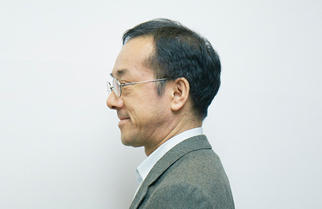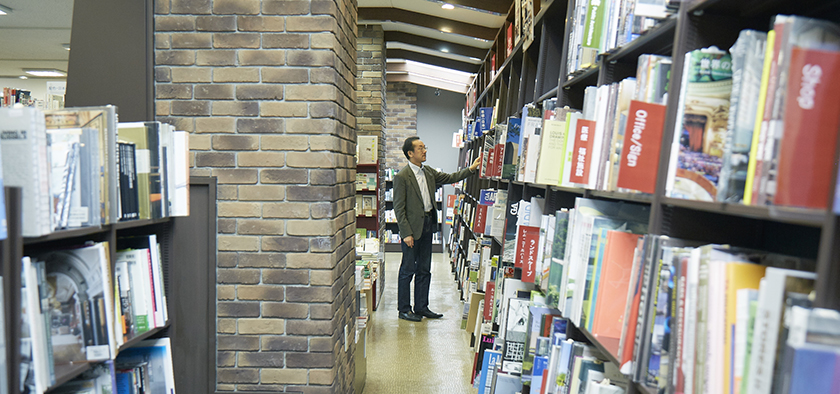
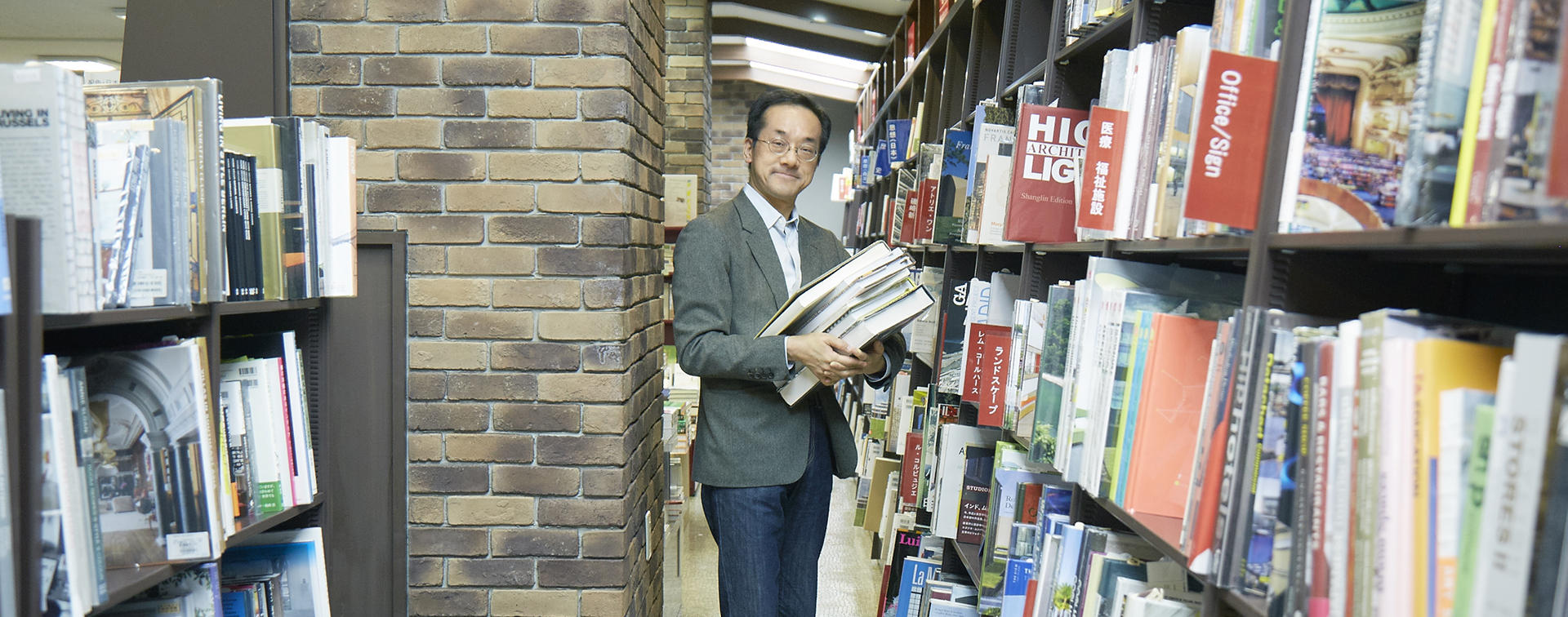
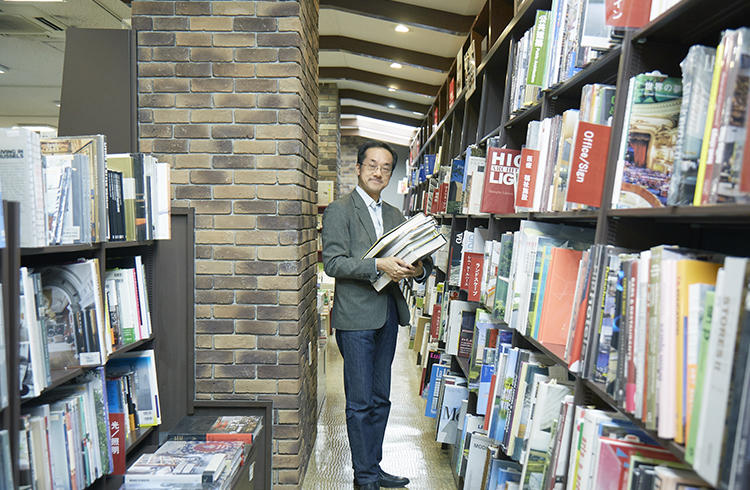
Looking at Roppongi from an environmental perspective
An area where people can spend their time as they like
Souhei Imamura teaches at Chiba Institute of Technology and many other universities in Japan and abroad, while designing architecture and writing books. He was involved with the "Foster + Partners: Architecture, urbanism, innovation" exhibition which will be held from January 2016 at Sky Gallery, the observation deck at Roppongi Hills. At the Tokyo Midtown DESIGN TOUCH event in 2015, Imamura talked about the environment for a class at "School in the Forest by Roppongi Future Talks." We asked him about his views on Roppongi. Listening to him was almost like taking one of his classes.
Roppongi in the '80s - discos, Aoyama Book Center, and Gallery Ma
When I was in my second year at college, I had a part-time job at the architecture firm Sakakura Associates which still stands behind the 21_21 DESIGN SIGHT building. In Roppongi at that time, there was an expectant atmosphere that something new would come out of this area; the AXIS building and Gallery Ma - which marked its 30th year this year - had just opened, and there was the bar NOMAD which Toyoo Ito-san had designed but which was demolished after only a year.
In those days, I often went to Aoyama Book Center (ABC) which used to be open until the morning. There was a shop beside ABC where you could make photocopies in the A1 size and I would browse the bookstore while waiting for copies to be made of large drawing sheets. With all kinds of books on architecture, art and the humanities, ABC was a chic and edgy bookstore - it still is. And of course, my memories of Roppongi include the times spent in discos. Perhaps you might think of discos as being glitzy places typical of the bubble era, but the admission fee was about 2,000-3,000 yen and it was actually cheaper than going somewhere for a drink because you could stay there for many hours. Students nowadays go to karaoke for the "nijikai" (a second party held after a main party) but in the '80s, going to a disco was like going to a karaoke bar.
After college, my visits to Roppongi became fewer, but after Roppongi Hills was built, I had more opportunities to come here again. Now Roppongi has Tokyo Midtown and the National Art Center, Tokyo, and the area seems to have expanded and become fuller.

Aoyama Book Center Roppongi
A book store that opened on Roppongi Dori in 1980. It has a wide selection of visual books, such as photography books and books on design and architecture. The book fairs held at the store reflect the current atmosphere of Roppongi. A popular store among artists and creators, it used to be open until 5 a.m. The main photo shoot for this interview was held inside the store. http://www.aoyamabc.jp/
Norman Foster -my hero since college days
When I was a student aspiring to become an architect, my hero was Norman Foster. I really admired him and when I later went to study in London, I went to look at his works all over Britain. There were none of his buildings in London then. Foster went on to become a globally renowned architect and I'm so glad to be involved in an exhibition of his works.
At the beginning of his career as an architect, Foster collaborated with Buckminster Fuller who advocated the philosophy of "Spaceship Earth". While there are many huge architectural firms around the world, the interesting thing about Foster's works is that they all reflect the philosophy gained through that collaboration. And that philosophy is very much in line with the environmental age we currently live in. For the exhibition, I'm co-operating in making two new models of buildings that Foster designed before he set up Foster + Partners.
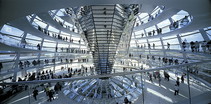
"Foster + Partners: Architecture, urbanism, innovation" exhibition (sponsored by Mori Art Museum)
The first exhibition to be held in Japan of "Foster + Partners", an international group of architects in charge of 300 projects in 45 countries including the new building for Apple's headquarters. On display are the architectural plans, models, and images of the group's roughly 50 representative projects. The exhibition will be held Jan1-Feb. 4 at the Sky Gallery of Tokyo City View, the observation deck at Roppongi Hills.
Foster + Partners
《The New German Parliament, Reichstag》
1992-1999
Berlin
Photo:Rudi Meisel
Innovative culture, greenery and restaurants
Whenever I'm asked which city I like, I always reply "Tokyo." Tokyo has Shibuya, Ginza, Akihabara; each town has its own character and that above all, is what makes Tokyo attractive. Contemporary cities need to keep changing in order to survive - this is evident if you look at cities like London or New York. It's important for Roppongi to have its own distinctiveness and be unlike any other place. Roppongi's future will be bright if it can transform itself in a way that is befitting to its character.
From an environmental perspective, I have to say that Roppongi is not an ideal place at all. The use of electricity is very bad for the environment, so a night town like Roppongi definitely fails to get good marks. (laughs) The other thing that is detrimental to the environment is commerce. Commerce is about stimulating people's desire to consume; in order to do business you need to be conspicuous. In the past, development meant simply constructing buildings, or simply having people live in buildings, but now, in towns all over the world, development has to be undertaken in tandem with commerce.
There's a need to strike a balance between the conflicting factors of energy and commerce. The big trend in cities now is to try to use less energy and to do activities like getting in touch with nature and appreciating food. So events like "School in the Forest" which I participated in the other day are being held - events that have a commercial element and which bring people together in relaxing places. There are many natural spots for relaxation in the countryside, but very few in urban areas like Roppongi. I feel that an ideal city of the future is one which has an innovative city culture, accessible greenery, many choices of food and a comfortable atmosphere.

Taking the initiative to find your place in a town
About two years ago, spaces for pedestrians were set up at Times Square in New York. A Japanese equivalent of Times Square would perhaps be the space in front of Shibuya station. In the most garish place, they've stopped the traffic and people are doing things like yoga. Maybe it won't be possible to do the same thing in Shibuya or Shinjuku because of the lack of space. But in Roppongi, there are places like Ark Hills, and we are beginning to see more open spaces. There seems to be a trend now of creating pleasant spaces and enhancing the value of towns.
In the last ten years or so, there's been a lot of discussion about civic pride as symbolized in the "I love New York" slogan. However frequently one goes to a town, it's difficult to love it if the town only has commerce. A purely commercial town only makes people passive. A lovable town is one where individuals can freely go about their own activities, where they can spend their time as they like and have a place to be themselves. Such towns are rare though. Compared to other big cities, I feel that Tokyo doesn't have enough places for individuals to spend their time as they please. In Europe, there are cafes and public squares and parks - places where you can just wander about.
I counted the number of times I've visited Roppongi recently and it turns out that in October, I came here seven times. Each time was for a different purpose such as meeting people to prepare for an exhibition or attending an opening event but when I look at my notebook, I see that as soon as the errand was over, I went back home. (laughs) I may have been busy, but I think the reason I didn't stay is that there are no places to while away the hours. Interesting events and programs alone are not enough in themselves to make people stay because in such cases, people are being passive and just taking what is given to them. To become personally connected to a town, one needs to know how to utilize it for one's specific needs.
A pedestrian zone in Roppongi Dori on the weekends
In the 1970s, information magazines like "Pia" and "City Road" were published, enabling people to find their own places in Tokyo. This trend was firmly set with the launch of the "hanako" magazine in 1988. Because of the information made accessible, people could make their own personal maps of Tokyo, choosing the places they liked out of a variety of places. And it was around that time that cities became mature and were able to offer the kind of values that people like readers of "hanako" were seeking.
I think that Roppongi is a little inaccessible to people because of the way the big commercial facilities have been built in a somewhat unconnected way. When you look at Omotesando which is now very well-known, you see that aside from that main street, there are other places like the "Urahara" area which are very accessible to the young people. Apart from the core facilities, there needs to be room for all kinds of other things so everyone can find what suits them and feel at home.
In order to make Roppongi into that kind of area, something needs to be done about Roppongi Dori. In Harajuku, people can enjoy walking around aimlessly, but Roppongi is divided by the traffic, and doesn't encourage that kind of wandering around. It might be a good idea to turn Roppongi Dori and Gaien Higashi Dori into pedestrian zones on Saturdays and Sundays - just like Times Square in New York. Roppongi has already tried out pedestrian zones in recent years; parades are held on some parts of the roads at Roppongi Art Night and Halloween.
Roppongi Halloween Parade
A Halloween parade sponsored by the shops and establishments in Roppongi. Traffic is partially restricted and costumed people walk the 1.7 km route from Roppongi Dori to Gaien Higashi Dori. There are also workshops and food stalls, and the event attracts many visitors every year.
The fun of utilizing contemporary cities to serve your needs
In order to utilize a city to serve your personal needs, you need to have knowledge. In the big cities especially, there are so many options in clothing and food and so on, and it's not easy to make wise choices. As one who works in architecture and cities, I cannot help hoping that people will become more literate about these things. Instead of being influenced by developers or capitalists or the media, people should use cities to fit their needs. Then there will be a synergetic effect. Today's cities become more fun and interesting the more you make use of them.
You need to gain experience by walking the streets and sometimes spending your own money at establishments. You might enter a restaurant and later regret it, but you learn from your mistakes. And it's helpful if you can get information from people who are knowledgeable about restaurants. In the past, young recruits used to be taken by their bosses to a yakitoriya (grilled chicken restaurants) where they would learn how to drink, or parents would take their children to their favorite unagiya (eel restaurants). But young people these days don't spend much time in towns. Perhaps we ought to have some sort of system to pass on information about how to spend time in the city.
To me, a good restaurant is one that has many regular customers - patrons who come often and who are obviously enjoying the restaurant. I suppose the same thing can be said about towns. What I find appealing about European towns is that you see many middle-aged men and women who are using the towns in line with their own needs. It becomes tiring when a town is filled mostly with people who do not actually live there.
Roppongi Art Night is an example of people unconsciously utilizing the city, and Halloween is a cultural event that lets people become personally connected to the town. The Halloween events are popular because people can take the initiative in participating. People have a lot of fun when they are not simply consumers, but are the players in a scene.
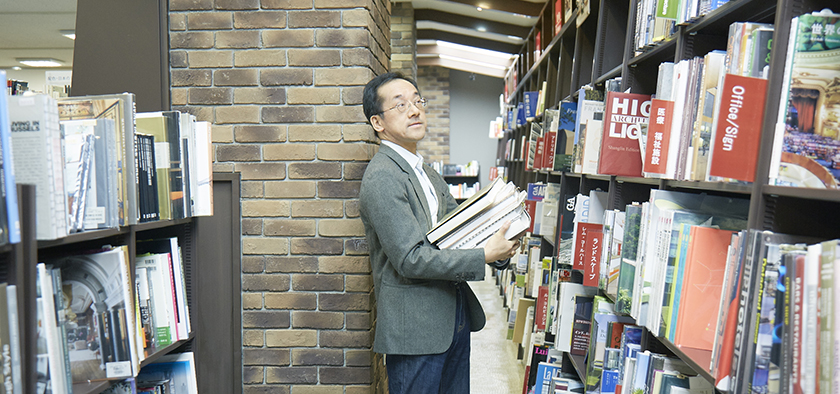
Roppongi is both artificial and natural
During the "School in the Forest" class, I talked about how the area of Roppongi is both very artificial and yet natural at the same time. Biologist Shinichi Fukuoka was saying in his book "Between the inanimate and biological" that animate beings can be defined as beings whose cells are changing. In other words, what differentiates artificial things from animate things is whether they are undergoing transformation or not. When you think of that, you could say that buildings themselves are manmade and unchanging, but on a wider scale, a city is continuously changing. That's one of the reasons I like Tokyo. While the changes may not be as big as they used to be in the era of high economic growth, Tokyo is vibrant because it continues to change. There is potential in cities which act like animate things.
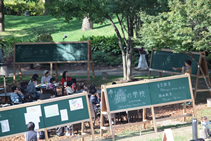
School in the Forest
The "School in the Forest" was a series of open-air classes held during the Tokyo Midtown DESIGN TOUCH event. The school originated from an idea given by a creator in a" Roppongi Future Talks" interview and marked the fourth time for an interviewee's proposal to be realized. The classes were held in Midtown Garden and were taught by nine teachers including Noboru Tsubaki who served as "headmaster". Imamura held a class on an environmental theme titled "Where we are."

"Seibutsu to museibutsu no aida" (Between the inanimate and biological)
A book by biologist Shinichi Fukuoka which won the Suntory Prize for Social Sciences and Humanities in the Life and Society department in 2007. The book examines the philosophy and achievements of genius scientists studying molecular biology, and ponders the big question of biological science: What is life? Published by Kodansha Gendaishinsho,.
This may sound like science-fiction, but there are views that smart phones are animate things in the sense that their applications are always increasing and changing. Human beings wear clothes because our skin alone cannot keep up warm, and we wear glasses or contact lenses when we have weak eyesight - we've invented all kind of devices as substitutes for body organs.
A pair of glasses seems to be part of a person's face; it's difficult to draw a line between what is you and what is not you. Everyone thinks that the simplest definition of a person is his mind. In other words, the brain is thought to be his essential identity. The brain can be described as "information". In this age of information, data is being transferred to the smartphone. The smartphone remembers even the things I've forgotten - from personal information to data related to my hobbies, all the information is up there in cloud storage for access by smartphone.
The future of billboards in the city
Let's return to the theme of cities. In Roppongi there are few digital billboards, but in places like Shibuya and Shinjuku, moving images flash by on numerous digital billboards. Perhaps you might presume that those adverts are information that advertisers want to send out, but the content of advertisements is gradually changing now, and being tailored to what viewer wants to see. So in Shibuya, the content of adverts is in line with the desires of the type of girls who like going to Shibuya. I think what will come next are billboards showing things that the majority of people most want to see at any given time. We already have computers and smartphones that show words we want to look up and adverts that are customized to our tastes.
If billboards come to show images in accordance with the desires of the people, it means that the scenery in cities will be influenced by what is on people's minds. That will be a considerable problem for architects since we will lose our jobs. The job of an architect is to design buildings, but if all the outer walls of the buildings were to be used as screens for projecting images, people will probably not want buildings that express the individual tastes of designers. Perhaps cities of the future will have projection mapping 24 hours a day. It would be unsettling, but then the billboards might perceive the fatigue of the pedestrians and show images of refreshing greenery. (laughs)
Diversity is what gives life to cities
About a 100 years ago, the streets were filled with the idle rich - people who were educated and had money but who didn't have anything to do. Such people were depicted in Natsume Soseki's novel "Sorekara" (And then). The city was where these people spent their time and a great number of cafés sprung up to cater to them. A city allows a person to be alone. There are people who don't enjoy doing the same things or getting comfort in the same things as everybody else. For example, there are women whose idea of fun is to hold all-female parties at cafés introduced in "hanako" magazine, and people who like to go to restaurants alone. There are all kinds of ways to use a city and there should be a wide range of places for people to spend their time.
Just as biodiversity enriches the ecosystem, diversity gives life to cities. Compared to other major cities abroad, I think Tokyo has a lot of diversity. Even its greenery is diverse. It's often pointed out that the total area of parks in Tokyo is small, but there's actually plenty of greenery and the number of living things per area is three times bigger than in London. That is because we're in a subtropical zone. The Japanese have always lived in an environment inhabited with many creatures as well as plants that will keep rapidly growing if left untended.
In Roppongi, there are the young men who work in the entertainment district, and there are the businessmen and the designers and artists. It's important for Roppongi to take advantage of its diversity. If it became a place for only a certain type of people, I think it would lose its appeal.
Editor's Thoughts
During the interview, Imai-san said a book he recommends is the biography "Norman Foster: Kenchiku to tomoni ikiru (Living with architecture)" published by Toto Shuppan - a translation of "Norman Foster: A Life in Architecture". It depicts how Foster, who was born into a working-class family, worked from the bottom up to become one of the world's most renowned architects. Perhaps you would be interested in reading this book. (edit_kentaro inoue)




